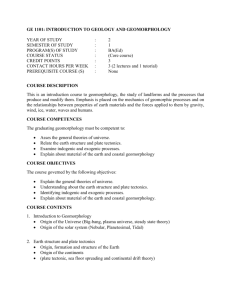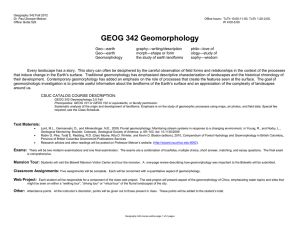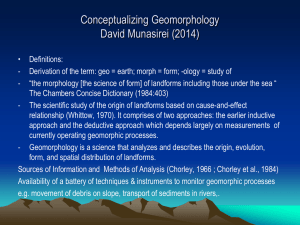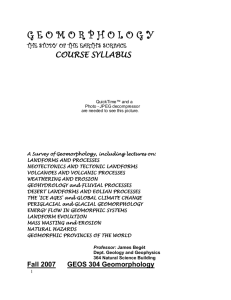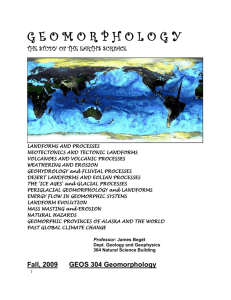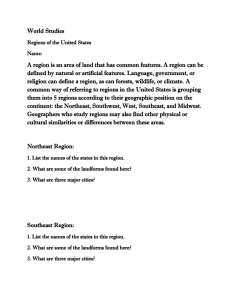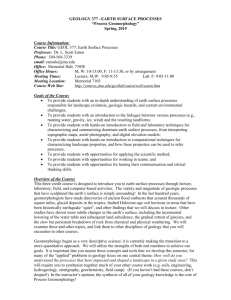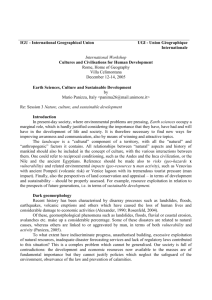Introduction to Geomorphology
advertisement
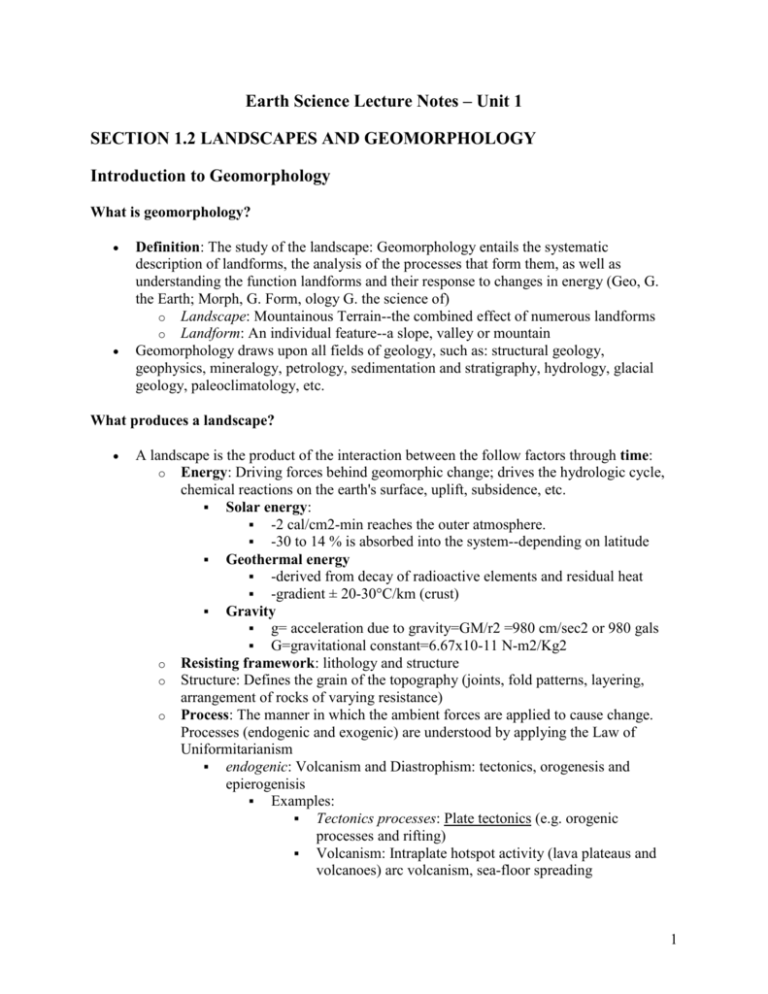
Earth Science Lecture Notes – Unit 1 SECTION 1.2 LANDSCAPES AND GEOMORPHOLOGY Introduction to Geomorphology What is geomorphology? Definition: The study of the landscape: Geomorphology entails the systematic description of landforms, the analysis of the processes that form them, as well as understanding the function landforms and their response to changes in energy (Geo, G. the Earth; Morph, G. Form, ology G. the science of) o Landscape: Mountainous Terrain--the combined effect of numerous landforms o Landform: An individual feature--a slope, valley or mountain Geomorphology draws upon all fields of geology, such as: structural geology, geophysics, mineralogy, petrology, sedimentation and stratigraphy, hydrology, glacial geology, paleoclimatology, etc. What produces a landscape? A landscape is the product of the interaction between the follow factors through time: o Energy: Driving forces behind geomorphic change; drives the hydrologic cycle, chemical reactions on the earth's surface, uplift, subsidence, etc. Solar energy: -2 cal/cm2-min reaches the outer atmosphere. -30 to 14 % is absorbed into the system--depending on latitude Geothermal energy -derived from decay of radioactive elements and residual heat -gradient ± 20-30°C/km (crust) Gravity g= acceleration due to gravity=GM/r2 =980 cm/sec2 or 980 gals G=gravitational constant=6.67x10-11 N-m2/Kg2 o Resisting framework: lithology and structure o Structure: Defines the grain of the topography (joints, fold patterns, layering, arrangement of rocks of varying resistance) o Process: The manner in which the ambient forces are applied to cause change. Processes (endogenic and exogenic) are understood by applying the Law of Uniformitarianism endogenic: Volcanism and Diastrophism: tectonics, orogenesis and epierogenisis Examples: Tectonics processes: Plate tectonics (e.g. orogenic processes and rifting) Volcanism: Intraplate hotspot activity (lava plateaus and volcanoes) arc volcanism, sea-floor spreading 1 Epierogenic processes: regional uplift and subsidence caused by mantle anomalies, glacioisostacy, etc. The role of isostacy exogenic: Examples: weathering and erosion Hydrologic cycle and related fluvial processes glaciation eolian biological activity and man (?) c. extragenic (my term)--meteor impact Importance: water (?) from comets? mass extinctions craters and large impact structures Important considerations Scale of the system: Relationship between size and duration Geologic history (relaxation time of past events) Magnitude and frequency of events affecting the system Geologic inhomogeneities (differences in structure, lithology, climate, etc.) Other Fundamental concept of geomorphology Time and history: landforms evolve through time. The age of the structure, length of time one or more processes have been in effect, and the sequences of geologic events all play a role in the evolution of a landscape. Response: Landforms are part of a system that reacts and changes to external forces. o Related concepts: Lag time: The time it takes for a landform to change in respond to a new set of conditions Relict landform: A landform formed under a previous condition. (e.g. New England's drumlins and other glacial features.) Equilibrium (self-regulation, homeostasis) o Perception of equilibrium state is a function of time: Static Equilibrium: no perceived change Steady State Equilibrium: Fluctuation about a mean Dynamic Equilibrium: Fluctuation about a moving average Dynamic Metastable Equilibrium: Fluctuation about a moving average marked by discontinuities Feedback: o negative feedback: reduces or alters o positive feedback : enhances or exacerbates 2 Some general classification landforms based on processes Constructional vs Destructional o Constructional Depositional processes: alluvial fans, deltas, etc. Endogenic processes: responsible for orogenies and regional uplifts that form most constructional landforms - Are there exceptions? o Destructional Processes involving the removal of material such as weathering and erosion--most exogenic processes Local events related to endogenic processes: certain types of explosive events Evolution of Geomorphic Theory and the introduction of important concepts Catastrophism: 18th and 19th centuries: Landscape had an innate permanence changed only by catastrophic events. Uniformitarianism (Hutton, 1785; Playfair, 1802, Illustrations of the Huttonian Theory of the Earth, Lyell, 1830, Principles of Geology:(cf. Darwin, 1859, Origin of the Species). o The present landscape can be explained by processes now observable. Geologic exploration by post Civil War geologist, western US--These geologists laid the ground work for Davis' work on cycles of erosion. Gilbert and Powell detailed the effects of streams and outlined the first geomorphic classifications of streams. o C Gilbert (1843-1918) introduced the concept of self-regulating equilibrium landforms, such as graded streams. [G. C. Gilbert, 1914, Report on the Geology of the Henry Mountains] o John Wessley Powell (1834-1902)--descriptive classification of streams; concept of base level; elaborated on the progressive erosion of mountain ranges Glaciation, Louis Agassiz, 1840, Etudes sur les Glaciers--made popular the theory of continental glaciation Landscape evolution (Historical approaches) o William Morris Davis (1850-1934): cycles of erosion o Walther Penck: The relative rates of processes (e.g. rate of uplift vs rate of denudation) controls landscape morphology (1894) Morphometrics: The application of statistics and mathematics to the analysis of landforms o e.g.Horton, 1954, Erosional development of streams and their drainage basins: GSA Bulletin, v. 82, p. 275-370. Systems approach: o Modern geomorphologist view a landform assemblage as an intricate system that can be studied by analyzing the variables or components that compose it. o The forces producing change (e.g. energy), the materials upon which the forces act (and their resistance to change), and the processes by which the change is produced are all considered. 3 Viewing landscapes as fractals: o Fractals: Objects exhibiting increasing detail with increasing magnification. Fractals are self similar in that the pattern viewed under magnification is similar to that of the whole. o All landscapes have fractal elements.--That's why a scale is important Examples: drainage networks, coastlines, sedimentary layers, etc. References Bloom, Arthur. 1998, Geomorphology, A systematic analysis of Late Cenozoic landforms, (3rd edition): Prentice Hall, Upper Saddle River, N.J., 482 p. Chorley, R.J., Schumm, S.A., Sugden, D.E., 1984, Geomorphology: Methuen and Co. Ltd., London, 605 p. Easterbrook, Donald J., 1993, Surface Processes and Landforms: Macmillan Pub. Co., 520 p. Hart, M.G., 1986, Geomorphology pure and applied: George Allen And Unwin, Boston MA, 227 p. Leopold, L.B., Wolman, M.G. and Miller, J.P., 1964, Fluvial processes in geomorphology. Freeman and Co., San Francisco, 522 p. Mayer, Larry, 1990, Introduction to Quantitative Geomorphology: Prentice Hall, Englewood Cliffs, NJ, 380 p. Morisawa, Marie, 1988, The Geological Society of America Bulletin and the development of quantitative geomorphology: GSA Bulletin, v. 100, p. 1016-1022. Morisawa, Marie, 1985, Rivers: Longman Inc., New York, 222 p. Ritter, D.F., Kochel, C.R., and Miller, J.R., Process Geomorphology (3rd Edition): Wm.C. Brown Publishers, Dubuque, IA, 544 p. Summerfield, M.A., 1991, Global Geomorphology. John Wiley and Sons, New York, NY, 536 p. Thornbury, William D., 1969, Principles of Geomorphology (2nd edition): Wiley and Sons, New York 594 p. 4
